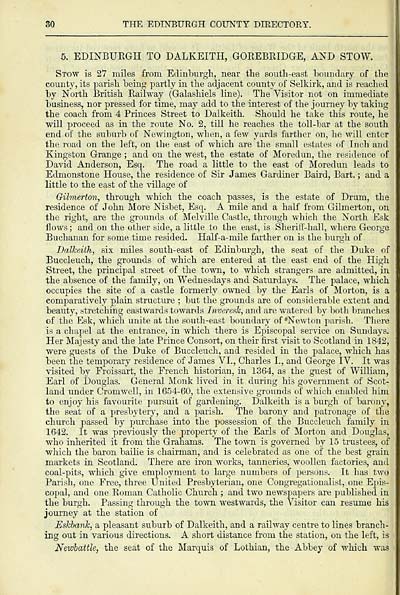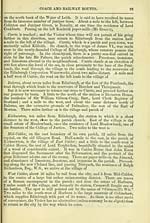Download files
Complete book:
Individual page:
Thumbnail gallery: Grid view | List view

30 THE EDINBURGH COUNTY DIRECTORY.
5. EDINBURGH TO DALKEITH, GOREBRIDGE, AND STOW.
Stow is 27 miles from Edinburgh, near the south-east "boundary of the
county, its parish "being partly in the adjacent county of Selkirk, and is reached
by North British Railway (Galashiels line). The Visitor not on immediate
business, nor pressed for time, may add to the interest of the journey by taking
the coach from 4 Princes Street to Dalkeith. Should he take this route, he
will proceed as in the route No. 2, till he reaches the toll-bar at the south
end of the suburb of Newington, when, a few yards farther on, he will enter
the road on the left, on the east of which are the small estates of Inch and
Kingston Grange ; and on the west, the estate of Moredun, the residence of
David Anderson, Esq. The road a little to the east of Moredun leads to
Edmonstone House, the residence of Sir James Gardiner Baird, Bart. ; and a
little to the east of the village of
Gilmerton, through which the coach passes, is the estate of Drum, the
residence of John More Nisbet, Esq. A mile and a half from Gilmerton, on
the right, are the grounds of Melville Castle, through which the North Esk
flows ; and on the other side, a little to the east, is Sheriff-hall, where George
Buchanan for some time resided. Half-a-mile farther on is the burgh of
Dalkeith, six miles south-east of Edinburgh, the seat of the Duke of
Buccleuch, the grounds of which are entered at the east end of the High
Street, the principal street of the town, to which strangers are admitted, in
the absence of the family, on Wednesdays and Saturdays. The palace, which
occupies the site of a castle formerly owned by the Earls of Morton, is a
comparatively plain structure ; but the grounds are of considerable extent and
beauty, stretching eastwards towards Inveresk, and are watered by both branches
of the Esk, which unite at the south-east boundary of "Newton parish. There
is a chapel at the entrance, in which there is Episcopal service on Sundays.
Her Majesty and the late Prince Consort, on their first visit to Scotland in 1842,
were guests of the Duke of Buccleuch, and resided in the palace, which has
been the temporary residence of James VI., Charles I., and George IV. It was
visited by Eroissart, the French historian, in 1364, as the guest of William,
Earl of Douglas. General Monk lived in it during his government of Scot-
land under Cromwell, in 1654-60, the extensive grounds of which enabled him
to enjoy his favourite pursuit of gardening. Dalkeith is a burgh of barony,
the seat of a presbytery, and a parish. The barony and patronage of the
church passed by purchase into the possession of the Buccleuch family in
1642. It was previously the property of the Earls of Morton and Douglas,
who inherited it from the Grahams. The town is governed by 15 trustees, of
which the baron bailie is chairman, and is celebrated as one of the best grain
markets in Scotland. There are iron works, tanneries, woollen factories, and
coal-pits, which give employment to large numbers of persons. It has two
Parish, one Free, three United Presbyterian, one Congregationalist, one Epis-
copal, and one Roman Catholic Church ; and two newspapers are published in
the burgh. Passing through the town westwards, the Visitor can resume his
journey at the station of
Eskbank, a pleasant suburb of Dalkeith, and a railway centre to lines branch-
ing out in various directions. A short distance from the station, on the left, is
Newbattle, the seat of the Marquis of Lothian, the Abbey of which was
5. EDINBURGH TO DALKEITH, GOREBRIDGE, AND STOW.
Stow is 27 miles from Edinburgh, near the south-east "boundary of the
county, its parish "being partly in the adjacent county of Selkirk, and is reached
by North British Railway (Galashiels line). The Visitor not on immediate
business, nor pressed for time, may add to the interest of the journey by taking
the coach from 4 Princes Street to Dalkeith. Should he take this route, he
will proceed as in the route No. 2, till he reaches the toll-bar at the south
end of the suburb of Newington, when, a few yards farther on, he will enter
the road on the left, on the east of which are the small estates of Inch and
Kingston Grange ; and on the west, the estate of Moredun, the residence of
David Anderson, Esq. The road a little to the east of Moredun leads to
Edmonstone House, the residence of Sir James Gardiner Baird, Bart. ; and a
little to the east of the village of
Gilmerton, through which the coach passes, is the estate of Drum, the
residence of John More Nisbet, Esq. A mile and a half from Gilmerton, on
the right, are the grounds of Melville Castle, through which the North Esk
flows ; and on the other side, a little to the east, is Sheriff-hall, where George
Buchanan for some time resided. Half-a-mile farther on is the burgh of
Dalkeith, six miles south-east of Edinburgh, the seat of the Duke of
Buccleuch, the grounds of which are entered at the east end of the High
Street, the principal street of the town, to which strangers are admitted, in
the absence of the family, on Wednesdays and Saturdays. The palace, which
occupies the site of a castle formerly owned by the Earls of Morton, is a
comparatively plain structure ; but the grounds are of considerable extent and
beauty, stretching eastwards towards Inveresk, and are watered by both branches
of the Esk, which unite at the south-east boundary of "Newton parish. There
is a chapel at the entrance, in which there is Episcopal service on Sundays.
Her Majesty and the late Prince Consort, on their first visit to Scotland in 1842,
were guests of the Duke of Buccleuch, and resided in the palace, which has
been the temporary residence of James VI., Charles I., and George IV. It was
visited by Eroissart, the French historian, in 1364, as the guest of William,
Earl of Douglas. General Monk lived in it during his government of Scot-
land under Cromwell, in 1654-60, the extensive grounds of which enabled him
to enjoy his favourite pursuit of gardening. Dalkeith is a burgh of barony,
the seat of a presbytery, and a parish. The barony and patronage of the
church passed by purchase into the possession of the Buccleuch family in
1642. It was previously the property of the Earls of Morton and Douglas,
who inherited it from the Grahams. The town is governed by 15 trustees, of
which the baron bailie is chairman, and is celebrated as one of the best grain
markets in Scotland. There are iron works, tanneries, woollen factories, and
coal-pits, which give employment to large numbers of persons. It has two
Parish, one Free, three United Presbyterian, one Congregationalist, one Epis-
copal, and one Roman Catholic Church ; and two newspapers are published in
the burgh. Passing through the town westwards, the Visitor can resume his
journey at the station of
Eskbank, a pleasant suburb of Dalkeith, and a railway centre to lines branch-
ing out in various directions. A short distance from the station, on the left, is
Newbattle, the seat of the Marquis of Lothian, the Abbey of which was
Set display mode to: Large image | Transcription
Images and transcriptions on this page, including medium image downloads, may be used under the Creative Commons Attribution 4.0 International Licence unless otherwise stated. ![]()
| Scottish Post Office Directories > Counties > Midlothian (Edinburghshire) > Edinburgh county directory > (36) |
|---|
| Permanent URL | https://digital.nls.uk/85990567 |
|---|
| Description | Directories of individual Scottish counties or parts of counties. |
|---|
| Description | Around 700 Scottish directories published annually by the Post Office or private publishers between 1773 and 1911. Most of Scotland covered, with a focus on Edinburgh, Glasgow, Dundee and Aberdeen. Most volumes include a general directory (A-Z by surname), street directory (A-Z by street) and trade directory (A-Z by trade). |
|---|


